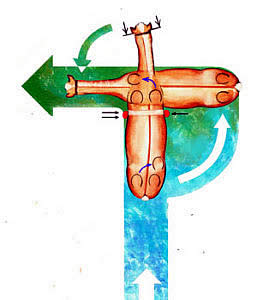To execute a proper forehand turn, you must have the correct balance between leg aid and pressure on the horse’s mouth. Jean Abernethy illustration.
Learn how to execute a correct forehand turn with these tips.
By AQHA Professional Horseman Michael Colvin in The American Quarter Horse Journal
Being able to do forehand turns and haunches turns (pivots or spins) with your horse gives you complete control of your horse’s body.
If you can do both of those things, then you are able to do any number of maneuvers that come into play once you can isolate and maintain control of both ends of your horse – sidepasses, counter-canters, circling a cow, etc.
That’s why in western horsemanship and hunt seat equitation, you are asked to do these turns. They allow you to show off your basic skills. The more precise you are with them, the better. If you can add speed, it increases the degree of difficulty and improves your score.
I think the forehand turn is a little more difficult for some people to learn how to do. It’s easier for people to control and move the front end of the horse (as in a turn on the haunches), than it is to move the back end for the forehand turn. For one thing, you have your steering in the front. It’s not more difficult for the horse; it just takes a little more practice for the rider.
For a horse to do a turn well, he must be secure in how to move away from the rider’s leg. A good bit of a horse’s instinct is when you push him, he pushes back. In training, our job is to teach a horse to move away from our leg, and that’s necessary to make this kind of maneuver happen.
The horse also must have respect for the bridle: he shouldn’t run through the bridle or ignore the rein aids that the rider gives correctly.
Common Problems:
- Aids coordination. It takes a lot of hand-leg-mind coordination to do a forehand turn and to do it precisely. You have to isolate one end of the horse’s body, maneuver it and maintain control of the other end. It takes coordination to get that to happen. For example, if you apply too much leg and not enough hand, your horse is probably going to leave the turn or just walk in a circle. If you use too much hand and not enough leg, you may get too much bend in the neck, or your horse is going to back up and out of the turn. You have to maintain the forward motion through the turn and not pull back too much.
- Resisting the leg aid. You have to get your horse to respond to your leg so he will actually move away from pressure. If your horse resists your leg, he’s not going to move at all. Riders often want to try to force the turn to happen with a spur. The more you try to force, it gives the horse more reason to push back against you. If you just dig your spur in, you’re not going to get a very good turn.
- Poor balance. If you don’t stay centered, it unbalances the horse and affects the horse’s desire to stay underneath you. It will be more difficult for the horse to maintain the turn, because he’s trying to maintain his own balance underneath an unbalanced rider.
What to Do
Part of perfecting forehand turns is for you to be clear on what needs to happen to get the results you are looking for. A turn is not just a matter of kicking the horse to the right or left.
You need to be educated as to what you’re trying to achieve and what needs to happen in what order. That’s a common pitfall: not being clear on what you’re trying to achieve. Check out the first step in perfecting this fundamental horse-training move:
Understand a correct forehand turn. In a left forehand turn, you use your left leg to move the hind end to the right, and the horse’s head revolves to the left. In a right forehand turn, you use your right leg to move the hind end to the left, and the horse’s head revolves to the right.
For me, the best way to remember that is to think the direction that the nose travels is the direction of the turn. Or the direction of the turn corresponds to the leg you use to move the haunches.
Watch a proper turn executed from the ground and see how the horse’s body and legs move. The body is straight from poll to hips, with the head flexed slightly to the left or right, depending on the direction of the turn. In a left forehand turn, the horse holds the left (inside) front foot still and moves the right front around that leg. The left hind steps forward and sideways, reaching across in front of the right hind. It’s a step forward and laterally, so that with every step, he moves around the circle a little farther.
Remember, the turn is a forward motion, and that’s certainly difficult for some people to grasp. As the horse turns, you have to push him forward, into the bridle, so his weight is forward.
© 2013 America’s Horse Daily
American Quarter Horse Association
1600 Quarter Horse Drive
Amarillo, TX 79104
